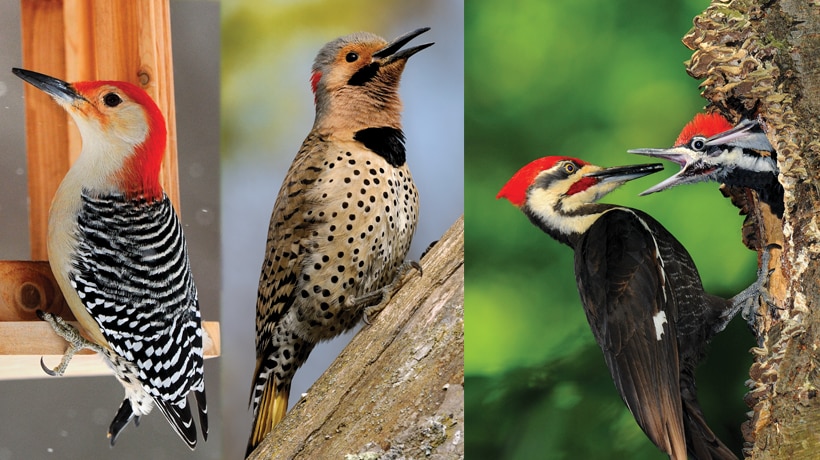Recognizing Woodpeckers in Florida: Habits, Types, and Habitats
Recognizing Woodpeckers in Florida: Habits, Types, and Habitats
Blog Article
Discover the Interesting Globe of Woodpeckers: Everything You Need to Know
The globe of woodpeckers is a realm full of unique habits, complex adjustments, and a varied selection of varieties. From their habitats and distribution patterns to their feeding routines and specialized anatomical functions, woodpeckers have long mesmerized the interest of ornithologists and nature fanatics alike. Understanding the complexities of these interesting birds gives a look right into the complicated interplay between their biology and the atmosphere. As we check out the globe of woodpeckers even more, we reveal a riches of info that clarifies their value in ecological communities and the obstacles they face in an ever-changing world.
Woodpecker Habitats and Distribution
In North America, for example, woodpeckers can be detected in both coniferous and deciduous woodlands, using their solid beaks to forage for bugs and create nesting cavities in trees. In Africa, specific woodpecker varieties have adjusted to dry settings, such as the acacia timberlands, where they play an important duty in controlling insect populaces.

Feeding Behaviors and Diet Regimen
Amongst the different elements of their behavior, woodpeckers show distinctive feeding behaviors and dietary preferences. These birds are primarily insectivores, with a diet regimen that includes ants, beetles, caterpillars, and various other insects located in trees. Woodpeckers utilize their strong beaks to pierce right into the bark of trees, probing for insects and larvae concealed underneath the surface. In enhancement to insects, woodpeckers likewise eat nuts, seeds, fruits, and sap. Some species have specialized tongues with barbed ideas that assist them extract bugs from holes in timber.
Woodpeckers are recognized for their drumming actions, which serves not just to interact with other woodpeckers however also to situate food. The quick drumming sound is produced by the bird pecking on powerful surface areas like dead trees or metal poles. This habits can draw in pests concealed in the wood, enabling the woodpecker to spot their presence and feed on them.
Unique Adaptations for Tree Climbing
In their proficient search of pests concealed within tree bark, woodpeckers have actually developed remarkable physiological functions that furnish them with unique adjustments for efficient tree climbing. One of the key adjustments is their zygodactyl feet, with 2 toes directing ahead and two pointing backwards, giving a solid grip on tree trunks. This specific foot arrangement permits woodpeckers to stick to upright surface areas effortlessly, allowing them to move up and down trees with agility. Furthermore, woodpeckers have stiff tail feathers that function as an encouraging prop while they climb, aiding in equilibrium and stability. Their strong, chisel-like beaks are not just used for exploration into timber yet also for grasping onto bark as he has a good point they ascend tree trunks. Woodpeckers have solid neck muscles and an unique skull framework that absorb the influence of continuous pecking, allowing them to climb up up and down without triggering damage to their brains. These adaptations showcase the amazing transformative layout that makes it possible for woodpeckers to navigate trees with accuracy and effectiveness.
Diverse Woodpecker Species Worldwide
With over 200 different species spread across different environments worldwide, the family of Picidae encompasses an exceptional variety of woodpeckers. These birds can be found in woodlands, woodlands, savannas, and also metropolitan areas, showcasing their versatility to various atmospheres. From the legendary Northern Flicker in The United States And Canada to the colorful and elusive Crimson-backed Flameback in Asia, each woodpecker types shows special attributes in regards why not try this out to plumage, actions, and environment preference.
Woodpeckers vary greatly in dimension, with the small Downy Woodpecker determining around 6-7 inches in length, while the effective Lineated Woodpecker can rise to 17 inches - Woodpeckers in Florida. Their beaks also can be found in different forms and sizes, showing their feeding habits. Some varieties focus on removing pests from tree bark, like the Acorn Woodpecker, while others, such as the Black-cheeked Woodpecker, feed on fruits and seeds

Conservation Initiatives and Challenges
Conservation initiatives for woodpecker populations are critical in mitigating the impact of environment loss and other risks dealing with these diverse bird types. Woodpeckers encounter numerous difficulties to their survival, largely as a result of logging, urbanization, climate change, and invasive types. To address these problems, conservation initiatives focus on securing and bring back woodpecker environments, implementing sustainable forestry methods, and increasing understanding concerning the value of these birds in communities.
One considerable difficulty in woodpecker conservation is the fragmentation of next their environments, bring about separated populaces that are much more at risk to termination - Woodpeckers in Florida. Guardians work to create wild animals hallways and shielded areas that attach these fragmented habitats, enabling woodpeckers to relocate between various locations for feeding, breeding, and sanctuary

Verdict
To conclude, woodpeckers are fascinating birds with special adjustments for tree climbing and feeding actions. They can be located in diverse habitats worldwide, facing conservation difficulties due to environment loss and human tasks. Understanding their environments, diets, and habits is essential for preservation initiatives to secure these vital bird species. Additional research and preservation actions are needed to guarantee the survival of woodpeckers in the wild.
Report this page